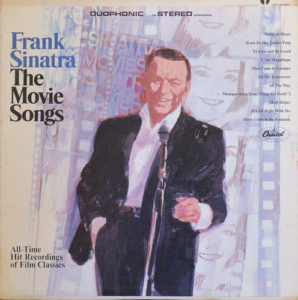 By Jerry Pearce
By Jerry Pearce
Frank Sinatra may have been one of the preeminent vocalists of the 20th Century, but it’s fair to say that his talents didn’t extend solely to the act of holding a microphone. Indeed, some have claimed that Sinatra was an even better actor then a singer, and if we overlook his vast recorded catalog, it’s quite obvious that Sinatra’s greatest advocation next to stretching his vocal cords was his performance ability in front of a motion picture camera.
From his first speaking role as himself in the RKO production of “Higher and Higher” in the 1940s all the way to his brief cameo in the 1995 CBS television film “Young at Heart,” based around a song of his, it’s hard to disagree that Sinatra had real presence on the theater screen, amplified by a body of movie work that rivals his recorded music and serves as ample proof that the singer belongs in that rare yet moderate category of 20th Century performers that had excelled both at musical and dramatic work, a talented group of individuals that includes Fred Astaire, Gene Kelly, Judy Garland, and so on.
There were many great moments in the Sinatra acting canon; some center his best performances during the peak of his acting career, when he made successful turns as the card dealing drug addict Frankie Machine in 1955’s “The Man With The Golden Arm,” or as the scrawny private Angelo Maggio in the film adaptation of “From Here To Eternity” (1953), a performance that would earn him an Academy Award and signal his show business comeback after a few years of career downturn. Others consider his best (and coolest) moments on camera to be during the “Rat Pack” films of the early 1960s, notably “Ocean’s Eleven” and “Robin & The Seven Hoods,” showcasing his knack for the debonair and sophisticate air of the character up to no good that you can’t help but root for. His later films, among them his roles as a mind-tortured United States Major in 1962’s “The Manchurian Candidate,” as well as his late performance as a conflicted New York City police sergeant in “The First Deadly Sin” (1980) also rank high on a Sinatra fan’s respective list of favorites.
In considering all of these films, we tend to forget how music played as big a part as the acting principals. Indeed, a fair deal of Sinatra’s films featured him in a musical performance of some sort. Some of these compositions he would adopt as his own, and he would use them in his concert performances right up to the end of his days on stage. Others were briefly used, but remain as components of important moments in his career. Here are some examples of notable songs created for Sinatra films:
All The Way
In 1957, Sinatra signed on to play nightclub comic Joe E. Lewis in the film production of “The Joker Is Wild,” and one of the songs written for the film by Sammy Cahn and James Van Heusen was the wistful ballad “All The Way.” Now considered a prime performance in the Sinatra canon, the song is memorable especially for a scene in the film in which a drunken Sinatra as Lewis sings the song to a nightclub crowd, in particular to an old flame who is now seated watching the performance with her new husband. Sinatra recorded the tune in two studio versions conducted by Nelson Riddle, one for Capitol in 1957 and again in 1964 for his Reprise Records. The song has endured so well that Celine Dion named one of her first compilation discs after the song, the disc featuring a digital duet of her and Sinatra singing the song, the technicians utilizing Sinatra isolated 1964 vocals in order to complete the tune.
Young At Heart
A 1954 film featuring Sinatra as the edgy songwriter Barney Sloan, who falls in love with his songwriting partner’s fiancée. Also featuring Doris Day, the Gordon Douglas-directed picture was a remake of the 1938 film “Four Daughters” and was yet another step up for Sinatra in his burgeoning reemergence as a performer following the success of “From Here To Eternity.” Although the film script plays it as if the fictional Barney Sloan wrote the tune, the title song was written by Johnny Richards and Carolyn Leigh (of “Witchcraft” fame), and was such a big hit for Sinatra after the release of the song as a single that the film was titled after the song. Sinatra would again re-record the tune after starting up Reprise Records, with Riddle and Sinatra laying down a new version in 1964.
The Tender Trap
For his 1955 outing with the recently departed Debbie Reynolds, Sammy Cahn and Jimmy Van Heusen wrote an original song for Sinatra’s film named after the title, the motion picture itself based on a Broadway play that opened the year before. Both Sinatra and Reynolds recorded version of the song for the film, Sinatra’s sung during the course of the opening credits as he advances toward the screen in his trademark suit and fedora. Sinatra liked the song so much, he recorded an alternate version with Nelson Riddle which was released as a single, charting up to number twenty-three in the United States as well a number two in England. For one of his first major records with Reprise some years later in 1962, Sinatra crafted a new version of the song for his outing with the Count Basie Orchestra, this chart created by the great Neal Hefti.
Bewitched
Richard Rodgers and Lorenz Hart created the musical “Pal Joey” in 1940 and when it went before the cameras at Columbia in 1957, Sinatra had been chosen to play the titular title character, the middle of a three-star “sandwich,” the phrase coined by Sinatra, flanked by the dynamic beauties of Rita Hayworth and Kim Novak at both sides. Sinatra’s first version of the tune appeared on the film’s soundtrack. He recorded a more notable version in 1963 with Nelson Riddle as part of the musical program of his new Reprise LP “The Concert Sinatra.” Coming full circle, he included this arrangement as part of a series of musical pairings for his final studio album, 1994’s “Duets II,” in which he traded lyrics with singer Patti LaBelle.
High Hopes
Another tune written by Sammy Cahn and Jimmy Van Heusen for a Sinatra picture, this one being the 1959 jaunt “A Hole In The Head,” in which Sinatra and child actor Eddie Hodges trade lyrics of the tune throughout the film. Sinatra recorded an alternate version with children’s chorus which was released as a single through Capitol Records and proved to be a hit recording, reaching number thirty on the Billboard 100 charts. However, it was most notable for what occurred after it became a hit. With the 1950s giving way to the 1960s and Sinatra emerging as a major campaign booster for his new friend, John F. Kennedy, the singer had Sammy Cahn craft a new set of lyrics for the song pertaining to his pal, the Presidential candidate, and Sinatra would perform the revised version as conventions and rallies supporting Kennedy as the next president. Few, if any, would doubt that Sinatra’s dedication to Kennedy’s campaign helped win Kennedy the presidency. Another timeless tune, the original hit single version was used a plot piece as recently as 2006, when the character of Rocky Balboa entered the Mandalay Bay arena for his most recent fight to the sound of Sinatra singing the song in a memorable scene from the Sylvester Stallone picture.
Heart of Mine
Although Sinatra didn’t appear in the 1962 film “Advise and Consent,” another all-star Otto Preminger movie affair, the singer was credited last during the opening starring titles, billed as featuring “the voice of Frank Sinatra.” Sinatra recorded a love song for the film, which became known under several different names, among them “Heart of Mine,” “The Loser’s Song,” as well as simply the “Love Theme From Advise and Consent.” Arranged and conducted by Jerry Fielding, the song was on its way to single release to coincide with the film debut, when the singer struck a blow. Upon discovering that his song was to be used during an overlong sequence featuring actor Don Murray traversing through an underground gay nightclub, Sinatra had the single pulled from circulation. It remained unreleased until it became available on the bootleg release of “Sinatra: The Soundtrack Sessions” in the mid-1990s, and then officially as one of the tracks of the movie career-spanning audio box set “Sinatra in Hollywood” in the early 2000s.
Until next time, Sinatra lovers!
Jerry Pearce is an amateur singer in the vein of Frank Sinatra, Perry Como, and Dick Haymes and has released two discs of standards music, Crossroads in 2010, and One Summer Night in 2016. Samples of his music can be heard on his YouTube Channel. To purchase his CDs use the form box below.
[si-contact-form form=’3′]

 February 13th, 2017
February 13th, 2017  CEO
CEO  Posted in
Posted in  Tags:
Tags: 



